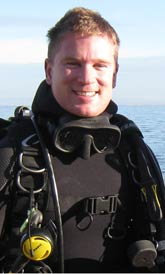« The Making of Under the Sea 3D | Main | Point Lobos Dive Profile »
December 08, 2010
Maui: Black Rock Dive Profile
One of my favorite Maui dive sites is Black Rock--a large lava rock that divides Kannapali Beach. It's known for being a great spot for night dives, cliff jumping and seeing some of Maui's biggest green sea turtles.
Black Rock is nearly 200 yards in length, running North-South. At its deepest it's only 30 ft. It's flanked by a reef that roughly 30 yards wide. Before diving Black Rock, contact Lahaina Divers and ask about the dive conditions. If the swell is coming from the South, conditions will likely be ideal. If the swell is coming from the North, be careful. The current at the North point of Black Rock has pulled divers out to the channel seperating Maui and Molokai.
It has two entry points, North of South. Unfortunatley, parking isn't easy. I recommend divers drive all the way to the North end of Kannapali Parkway, just past the entrance to the Sheraton Maui Resort and Spa. Park the car, remove your gear and place it on the grass next to the golf course. Make sure someone stays with the gear while the driver parks the car. Driving South on Kannapali Parkway, there is a small, I repeat, small parking lot North of Whalers Village. Parking is usually avilable before 9 am. After that, good luck.
Gear up on the grass, then walk along the path towards the Beach. There is beach access after you cross the bridge over the golf course fresh water runoff canal. Once you're at the beach, double check your dive gear and then enter the water.
You'll swim South along the North point of Black Rock. The first thing you'll notice is that the brakish fresh water from the golf course mixes wit the salt water--creating an onion-soup like mess that reduces visisbility. Stay the course! It quickly clears up. Swimming South, Black Rock will be on your left. I recommend swimming close to the wall on your way down, then swimming to the outside of the reef on your way back.
Along the wall there, are numerous small caves that green sea turtles use for shelter. During my last trip, my girlfriend Carolina and I nearly aborted our dive due to laughter when we stumbled upon a turtle at least 5 ft. long with its head stuck in a tiny hole and the rest of its body out in the open. While this defense may work for ostriches, it doesn't work for green sea turtles.
The small holes littering Black Rock are also a favorite home for moray eels. I've seen moray's on almost every dive I've made there. I've even seen multiple ones sharing the same hole. While moray eels are beautiful, they also bite, so be careful not to get too close.
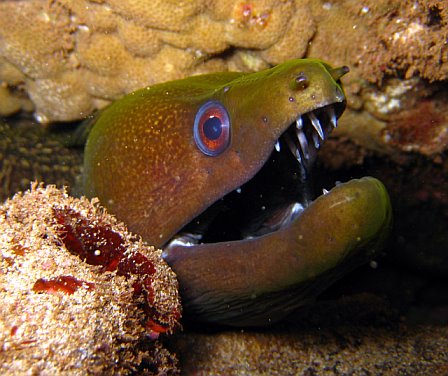
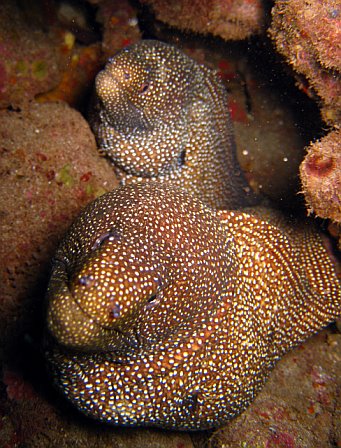
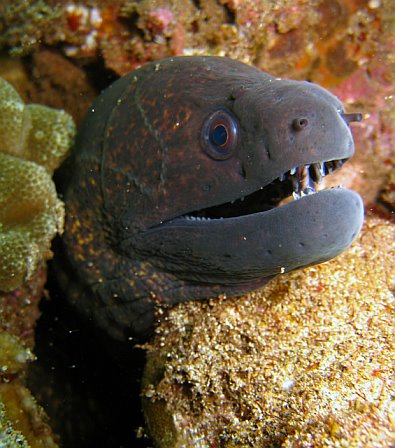
Also keep your eyes peeled for small, brightly colored objects that don't quite fit in with their surroundings. They're likely frog fish--a type of anglerfish. Frogfish are a favorite subject for photographers and videographers, but it's not because of their looks. Frogfish are stocky, ranging in size from 1-15 inches long. Their brightly colored bodies have no scales and are covered in algae or hydrozoa to help them blend in with their surroundings. Frogfish use their pectoral and pelvic fins like hands to hold themselves in place on a reef or walk along the sea floor and hunt by lying motionless until prey approaches. Then, in a fraction of a second, they open their mouths, take a deep breathe and swallow their prey whole.
For me, a trip to Black Rock isn't complete without seeing at least one frogfish.
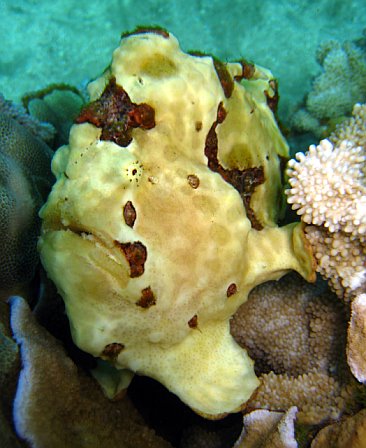
Work your way down Black Rock until you reach the South-most point. You'll know you're there when the wall takes a sharp turn left, running East, and you see people diving into the water. Then, turn around and head back North. I recommend sticking to the outside of the reef this time, instead of hugging the wall.
Keep an eye out for green sea turtles. Sometimes I like to sit in the sand at the South Point of Black Rock waiting for them to swim by. On a single dive one afternoon I counted 14 turtles swimming South. I'm not sure why, but the green sea turtles seem to use Black Rock as a South-bound highway in the late afternoons.
On the outside of the reef you'll likely come across several green sea turtles resting in the sand. While most will swim away when approached, some are inquisitive. During the last dive I made at Black Rock, a turtle crawled across the sand towards me, stopped, then lifted its face to my mask. Inches away, the green sea turtle analyzed my mask for several minutes. It is one of my most memorable diving experiences.
I hope your dives at Black Rock are as memorable as mine.
Posted by jroualdes at December 8, 2010 10:32 PM








